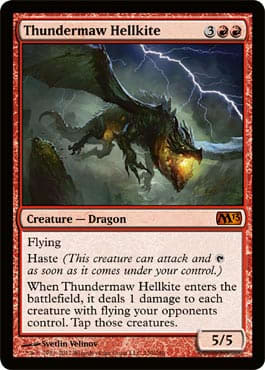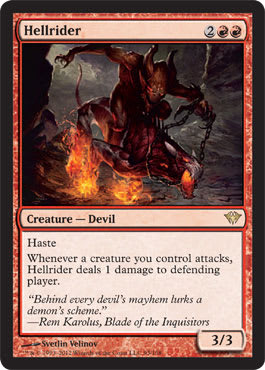I was struggling all weekend with a way to tie the great guild of experiments and risk into Magic finance, and all the while, the answer was right in front of my face. I asked the Twitterverse what they thought would be a good theme for this week, and instantly, I received almost the exact same response from a great number of people. In fact, there is almost no other guild that ties in with Magic finance than Izzet—called shots are like experiments, and the risk associated with both can be tremendous. I have talked about the different ways to evaluate cards in regard to where their prices will probably go in the coming months, and I have talked about what I look for in a call, but I have never talked about how to manage the risk of these so-called experiments.
As with any experiment, you should base your Magic investments off a hypothesis. This can be something as simple as realizing a card such as Bonfire of the Damned is seeing less play and therefore is likely to drop in price. Most people take these types of statements for granted, but you would be surprised how many people still accept the market price on cards that are obviously a failed experiment. Looking at the metagame versus the current market is one of the easiest and least risky management tools you can use and is probably among the most important factors when evaluating your stock. I am sure most of you are wondering why I would even mention something so simple in regards to Magic finance, but it is hard to understand the process that goes into making more risky investments or experiments if you do not understand the basic components.
So, once you understand the basic concepts of what goes into the decision to push all-in on a card or sell out while you can, what factors determine what cards to look for? If you are in a trade and looking for cards you believe will spike, it is far different than looking to buy out stores or people of a particular card. These small determining factors can be the difference between turning a profit and sitting on a ticking time bomb.
So, what do I mean when I say it is important to know how you are trying to obtain these cards, and why is that relevant? When I am evaluating cards, the first question I ask myself is what I think the ceiling is. If you believe a card that is currently $10 can reach $15 in the next few weeks, would you rather trade for it or buy it from a store to profit? If you are looking to resell the card in the near future for a profit, it is unlikely you would want to pay $10 initially only to turn it into $12 to $13 on a buy list or in hopes that a player will want to pay you full retail on a set. That does not mean the cards is not worth picking up; I would just stick to the trading side of the financial world to obtain my copies. If you can trade them in at $10 and trade them out a few weeks later for $15, that is a solid margin, far better than hoping to make $2 to $3 in cash for each copy.
The above example also brings about another point that is important to remember when dealing in Magic finances: Cardboard is always easier to risk than paper. This may seem obvious, but when you are looking to make a small-margin profit, you are far safer sticking to trading out cards for them, meaning even if the card does not spike, you can still trade them away for the same value assuming they do not drop. If you were to have bought in at $10 and the card stayed stagnant for the duration of the experiment, it is unlikely you would be able to resell those same copies and take your full initial investment back.
So, when is it best to go deep on a card and invest some of your hard-earned money on a possible profit? The time I find myself most often willing to invest cash on a chance such as this is when the cash value is actually lower than the trade value. A card such as with my recent experiment, Séance, is the perfect example of for which you may have better luck investing some cash rather than trying to trade for a card. Typically, most people will not trade any rares lower than $1 just for the simple fact that it is rare. This may not always be the case, but very few people want to accept a quarter on a card when they are trying to trade for your $20 card. In scenarios such as this, if you believe the market can reach a high enough price to take a card from being bulk to at least doubling your initial investment on a buy list, I believe it is worth investing.
There are multiple advantages to those willing to invest more than just cardboard in this market, but there is also a greater level of risk. One of the major advantages is the ability to acquire as many copies as you want almost instantaneously. When you are trading for a particular card, you are limited to the number of copies in your local area if you do not travel, and although it is fine to pick up $10 or $15 copies of a card hoping to make a few bucks, it will not yield you nearly as large of a reward as the ability to buy hundreds or thousands of copies from online retailers.
Another advantage to buying out the online market is that you are likely to do some of the work to make the card rise as a nice side effect. If you purchase a large quantity of cards form some websites, many of their systems—whether automated or manual—may raise the price. This alone will not do enough to allow you to turn a profit, but it at least puts the card on the vendor’s radar, and combined with some solid tournament results for the card, you are likely to see a faster return than if you just quietly trade for a card in your local area.
So, outside of small cards, when should you be looking to go deep on a cash investment? The real answer to that lies in how much risk you are willing to take. I have more money in this game than most people, and therefore, taking a few-hundred-dollar loss is not all that backbreaking for me. If you are a college student or don’t have the extra income to throw at cardboard, however, it can be a far more difficult task when choosing your battles. Until you become comfortable with your skills, I would suggest just investing in cheap cards that have the potential to rise from fifty cents or $1 to a few bucks each. This ensures that you will not take a huge loss, but it also allows you a healthy margin if you are correct.
For those with slightly more money available to tie up in cardboard, I would look for format gaps. What I mean by that is: What is a format missing to shut down the top-tier decks, and what are the top-tier decks missing to become the most dominating builds they can be? I spoke of Thundermaw Hellkite recently as a perfect example of what I mean. If you can manage to find this card before the price spike, you are likely to be able to turn around a quick profit because you can bet the metagame is not too far behind you. In the modern day of the game, with all of the information-sharing available, the price on a card can fluctuate overnight without any real stern results, and although this may at times catch you with your pants down, it also means if you did hit a card early, you will not have to wait long to flip it for a strong gain.
A few weeks ago, I discussed the new section of this series I will be including each week in regards to price fluctuation and watching the market. Since I skipped last week, I want to cover a few extra things this week—and not just singles either.
Hellrider – This guy is all over the online metagame, and on paper, he is just a little over $5. This will probably change as the real world meta catches up, and I could see him spiking to $10 if mono-red proves to be as dominant in paper as it is in the digital game.
Craterhoof Behemoth – Though it may be a little late to get in on this guy cheap, I feel you can probably still pick some up below $5 in trade. If Frites continues to show its ugly head in Top 8 after Top 8, I would not be surprised to see the card climb even higher.
Duel Deck: Izzet vs Golgari – This may seem like a strange pick up since they are everywhere, but of all of the duel decks I have seen in recent years, this one seems to be a great long-term investment. The package has something for everyone, from Life from the Loam to Niv-Mizzet, the Firemind, and it is chock-full of highly playable alternate arts. I would not be surprised if these are $40 or more within a year.
Join me next week as I go back a few months and review just how accurate I was in regards to Return to Ravnica. I managed not to look at presale prices before I made my predictions, so let’s see if that hurt or helped me in the long run. If you have any questions or comments, leave them below or contact me on Twitter as always. Thanks for reading, and I hope to see some of you in the coming weeks across the slew of Grands Prix I will be attending.
Ryan Bushard























